

|
|
Ships the USS Helena CL-50, sailed with, during WWII.
Ships named below, are mentioned in a number of the CL-50 War Diary files.
HMNZS Achilles first found in USS Helena CL-50 War Diary for 4 August 1942, Name: HMS Achilles Name: HMNZS Achilles HMNZS Achilles was a Leander-class light cruiser which served with the Royal New Zealand Navy in
After Japan entered the war, she escorted troop convoys, then joined the ANZAC Squadron in the south-west Pacific.
Achilles met Canberra, flagship of Rear-Admiral John G. Crace, and Perth in December 1941 to form
While operating off New Georgia Island with US Navy forces, a bomb damaged her X turret on 5 January 1943.
After Second World War service in the Atlantic and Pacific, she was returned to the Royal Navy. She USS George F. Elliott (SS Delbrasil) first found in USS Helena CL-50 War Diary for 5 August 1942, USS George F. Elliott (AP-105) Awards
USS George F. Elliott (AP-105) was a cargo liner built for the Mississippi Shipping Company as SS Delbrasil
Delbrasil was allocated by WSA to the United States Navy under a sub-bareboat charter at San Francisco on
From 3 October 1943 to 31 January 1944 two troop-carrying voyages out of San Diego brought fighting men USAT Ludington first found in USS Helena CL-50 War Diary for 1 August 1942,
No FY assigned. This ship was the last of 11 large freighters built by the Pennsylvania Shipbuilding Co.
Back in 1935 the Army and Navy had agreed that the Army would operate its own ships except where
The Navy soon decided that the nine Army cargo ships on this list were unsuitable for operations in hostile USS Dale first found in USS Helena CL-50 War Diary for 10 August 1942,
Class and type: Farragut-class destroyer
The fourth USS Dale (DD-353) was Farragut-class destroyer in the United States Navy during World War II.
At the commencement of the raid on Pearl Harbor, T.H., at 0750, December 7, 1941, the Dale was moored
At 0820 it was reported to the senior officer in the nest, Lieutenant Commander W.P. BURFORD, U.S.N., commanding
1114, the U.S.S. Worden (Commander Destroyer Squadron ONE) sortied. The Dale formed on the Worden as third ship in
There were no casualties on board and no damage was caused by the Japanese. The Japanese plane shot down by the Dale
From 14 December 1941 to 17 March 1942, Dale screened Lexington and Yorktown, covering the strikes on the Salamaua–Lae USS Kanawha (AO-1) found in USS Helena CL-50 War Diary for 14 August 1942, USS Kanawha (AO-1) Awards
Laid down: 8 December 1913
Class and type: -class fleet replenishment oiler The third USS Kanawha (AO-1) (originally Fuel Ship No. 13) was the first purpose-built oiler of the US Navy.
The oiler was at Mare Island undergoing overhaul at the time of the Japanese attack on Pearl Harbor. Kanawha departed
On 7 April a group of Japanese Vals slipped through fighter defenses and zeroed in on Kanawha as she awaited an escort USS Gamble (DD 123) found in USS Helena CL-50 War Diary for 16 August 1942, CLASS - WICKES (LAMBERTON)
Operational and Building Data
On 7 December 1941, Gamble had returned from offshore patrol, when her peaceful Sunday morning
On 27 August 1942, Gamble joined a task unit headed to Guadalcanal. Although designated a destroyer-minelayer,
Five minutes after midnight, 6 May 1943, Gamble, with Preble and Breese, turned simultaneously in rain squalls which USS Aylwin (DD 355) found in USS Helena CL-50 War Diary for 19 August 1942,
USS Aylwin (DD-355) was a Farragut-class destroyer, and the third ship of the United States Navy Class and type: Farragut-class destroyer
As Aylwin lay moored in a nest with her squadron mates on the morning of 7 December 1941, one small
Three minutes later, Aylwin returned fire. At 08:00, the "black gang" lit fires under two boilers, cutting them in on
The destroyer, manned by 50% of her crew under the direction of four ensigns—the senior officer, Ensign Stanley
As Aylwin raced out to sea, those men topside who chanced to look astern beheld a curious sight; her captain,
Late on the afternoon of 8 December, Aylwin followed the Enterprise task force into Pearl Harbor and picked
Aylwin sortied as part of the Lexington task force headed to relieve Wake Island on 14 December. Along with the USS Manley first found in USS Helena CL-50 War Diary for 19 August 1942,
USS Manley (DD-74/AG-28/APD-1), a Caldwell -class destroyer , served in the United States Navy.
At dusk on 11 April 1942, she picked up 290 survivors from the torpedoed merchant passenger steamer
Carrying bombs, ammunition, and gasoline, Manley and (DD-83) got underway on 16 August. After exchanging
Ordered to cut out all topside weight on the ship, her crew removed everything not essential to survival, painted the ship
On 8 September 1942 Manley took part in a surprise landing on Taivu Point, Guadalcanal, by the 1st Marine Raider Battalion.
As she was unloading, the shore station ordered her to clear out at highest speed, since a raid by Japanese heavy units was
A company of marine raiders came on board on 31 October 1942 with orders to establish a beachhead at Aola Bay,
The versatile fighting ship left Nouméa on 20 November 1942 carrying six torpedoes, towing two PT boats, and escorting
Manley arrived at San Francisco, California on 12 June 1943 for overhaul at Hunters Point Navy Yard. Then, on 1 August 1943,
Manley arrived at Pearl Harbor on 14 December 1943 and joined the V Amphibious Corps to prepare for Operation Flintlock,
The two high-speed transports were ordered to land 7th Cavalry Regiment reconnaissance troops on Bennett Islands before
Three days later Manley got underway as part of a transport screen for Hawaii, arriving Pearl Harbor on the 15th to train Army
On 30 May Manley joined Task Group 52.15 (TG 52.15) and departed for the invasion of Saipan. The high-speed transports
On 10 September Manley took on board 50 tons of explosives, slated as reserves for underwater demolition team work in the
After entering Leyte Gulf, Manley was assigned screening stations off the southern transport area at Dulag. On the 19th she picked
En route, part of the convoy, including Manley, was diverted to Seeadler Harbor, Manus, Admiralty Islands, and anchored there on USS Mercury first found in USS Helena CL-50 War Diary for 26 August 1942, USS Mercury (AK-42) Awards
Ordered: as MS Lightning, C2 Cargo hull, MC hull 16 General characteristics
Displacement: 7,345 t.(lt), 10,850 t.(fl)
Length: 459 ft 2 in (139.95 m) USS Mercury (AK-42) was a cargo ship commissioned by the U.S. Navy for service in World War II.
The fifth ship to be named Mercury by the Navy, AK-42 was launched as SS Lightning by
Throughout her World War II service, Mercury operated in the Pacific Ocean, beginning with long USS Cimarron first found in USS Helena CL-50 War Diary for 31 August 1942, USS Cimarron (AO-22) Awards
USS Cimarron (AO-22) was a Cimarron -class oiler serving with the United States Navy and the second ship
Cimarron cleared Houston 31 May 1939 for Pearl Harbor, arriving 21 July. She transported oil between west
Cimarron departed Pearl Harbor 29 September 1943 with the force which raided Wake Island on 5–6 October, and USS Guadalupe first found in USS Helena CL-50 War Diary for 31 August 1942, USS Guadalupe (AO-32) Awards
USS Guadalupe (AO-32), a Cimarron-class fleet replenishment oiler that served in the United States Navy,
Guadalupe was launched as SS Esso Raleigh 26 January 1940 by the Newport News Shipbuilding &
Six weeks of coastwise voyages carrying oil from Texas to New Jersey ended 16 August as Guadalupe
In January 1942 Guadalupe sailed to the Pacific, where she was to participate in virtually every major campaign
As the United States launched its first offensive effort in the Pacific, Guadalupe sailed south to spend the final four

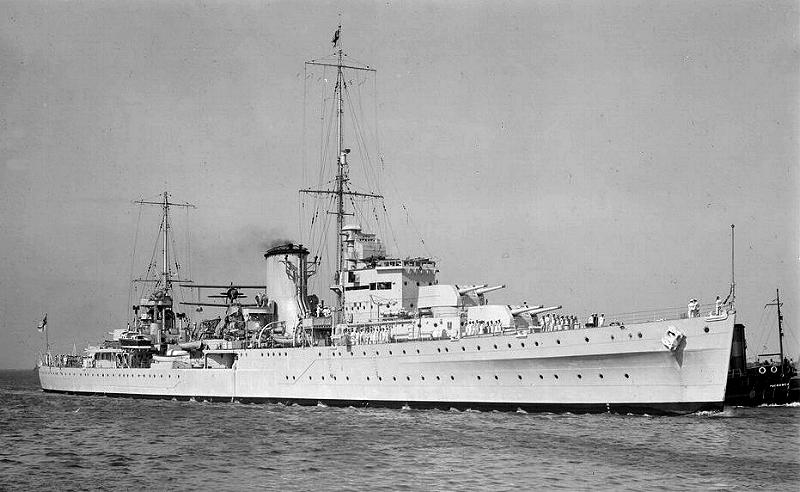
Namesake: Achilles
Builder: Cammell Laird, Birkenhead, England
Laid down: 11 June 1931
Launched: 1 September 1932
Commissioned: 10 October 1933
Out of service: Loaned to Royal New Zealand Navy1 October 1936
Identification: Pennant number: 70
Honours and awards: River Plate 1939
Fate: Sold to Indian Navy 5 July 1948
Commissioned: 1 October 1941
Decommissioned: 17 September 1946
Identification: Pennant number: 70
Honours and awards: Guadalcanal 1942-43, Okinawa 1945
the Second World War, the second of five in the class. Originally constructed by the Royal Navy, she was
loaned to New Zealand in 1936 before formally joining the new Royal New Zealand Navy in 1941. She
became famous for her part in the Battle of the River Plate, alongside Ajax and Exeter and notable for
being the first Royal Navy cruiser to have fire control radar, with the installation of the New Zealand-made
SS1 fire-control radar in June 1940.
an escort for the Pensacola Convoy.
Between April 1943 and May 1944 Achilleswas docked in Portsmouth, England for repairs. Her damaged X
turret was replaced by four QF 2 pom poms in a quadruple-mount. Sent back to the New Zealand Fleet, Achilles
next joined the British Pacific Fleet in May 1945 for final operations in the Pacific War.
was sold to the Indian Navy in 1948 and recommissioned as INS Delhi. She was scrapped in 1978.
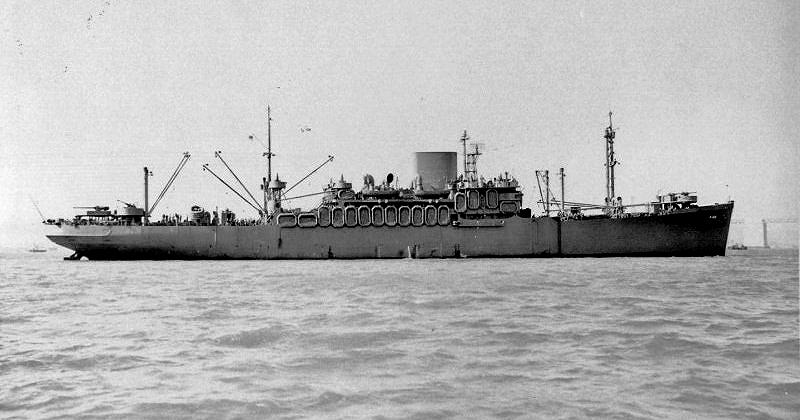

for operation between New Orleans and the east coast of South America in 1939 by its operator, Delta Line.
The ship entered that service and operated until taken over by the War Shipping Administration (WSA) on
28 April 1942 for operation by Delta Line acting as WSA's agent. On 25 August 1943 WSA allocated the
ship to the Navy for conversion to a troop transport commissioned and operated by the Navy for the
duration of the war. Ownership of the ship was transferred from Mississippi Shipping to WSA on
4 February 1944 while under Navy operation and was retained until sale to American South African
Lines on 22 December 1948. The ship was renamed frican Endeavor until returned as a trade in to
the Maritime Commission on 22 September 1960 for layup in the James River reserve fleet and later
sold to Boston Metals for scrapping.
25 August 1943 to serve as the troop transport George F. Elliott during World War II. She was commissioned
as USS George F. Elliott on 23 September 1943, Commander A. J. Couble in command, and the second
US Navy ship to bear the name (the first being the transport AP-13, which was lost to enemy action in August 1942).
to Nouméa, Guadalcanal, and Espiritu Santo. On 4 February title to the ship was transferred from Mississippi Shipping
Company to WSA while the ship was at sea. Subsequently, George F. Elliott left San Francisco on 18 February to
embark cargo and over 1,700 sailors and marines at Port Hueneme . She steamed thence to Havannah Harbor,
New Hebrides, arriving on 9 March, and for the next two months made troop shuttle voyages between Espiritu Santo,
Guadalcanal, the Russell Islands, Manus, and New Guinea before putting in at Pearl Harbor on 7 May 1944.
Below Photo No. SC-190724 on 8 January 1942 at Fort Mason, San Francisco.
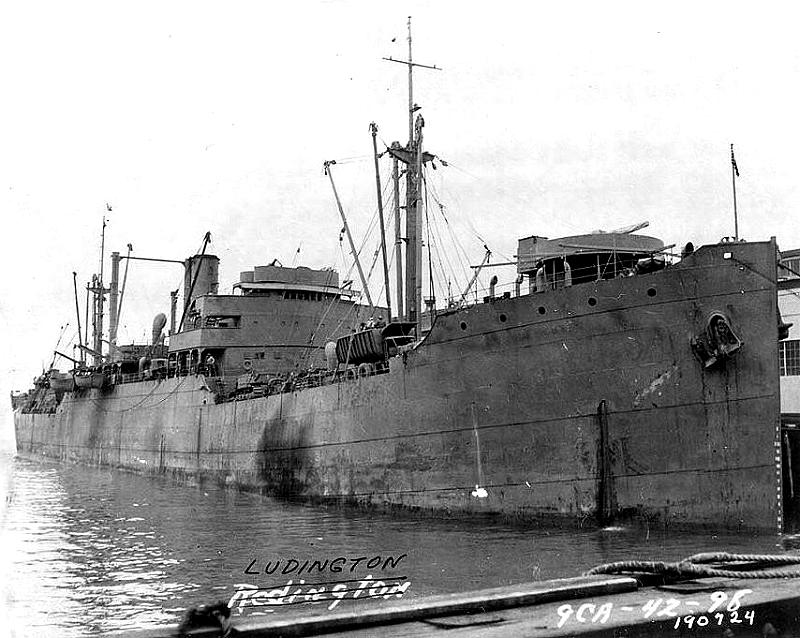
Design: Cargo, 1920
Displacement (tons): 8,266 gross, 13,750 dwt
Dimensions (feet): 455.0' oa, 439.5' pp x 60.2' x 28.5' load
Original Armament: 2-4"/50 (1942: actual)
Later armaments: --
Complement: 94
Speed (kts.): 11.5
Propulsion (HP): 3,400
Machinery: Turbine, 1 screw.
(later taken over by the Pusey & Jones Co.) at Gloucester City, N.J. during World War I. Ordered by
commercial shipping firms, all were requisitioned by the Shipping Board in August 1917. All but the
first were named after famous American patriots. Their design was numbered 1135 by the Shipping
Board after World War I. The Army took over JAMES OTIS in 1930 or 1931 and renamed
her LUDINGTON.
naval opposition was expected, in which case the ships would be Navy manned. However, experience
in the first part of World War II indicated that naval opposition by the enemy, in the form of submarines,
could be encountered anywhere. In April 1941 the CNO proposed to the Chief of Staff of the Army that
a board review the issue. The Board recommended on 28 Apr 41 that the Army "surrender operation of
its transport service for the term of the present emergency" following procedures that it enumerated, the
first of which was that the Navy would commission the Army transports with Navy crews as soon as possible.
(The Army used the term "transports" for all ships in the Army Transport Service, including cargo ships and
other types.) On 14 May 41 the Auxiliary Vessels Board recommended the implementation of this plan,
which then covered 26 Army ships, and on 22 May 41 the Secretary of War approved the transfer of the
ships, noting that jurisdiction over each ship was to pass at the time it was manned by the Navy. On 5 Jun 41
the Secretary of the Navy approved names for the 26 ships, all but three of which (AP 21-22 and AK-39)
retained their Army names. The hull numbers AP 20-36 (less 23), AK 32-40, and APL-1
(for the barracks ship in Newfoundland) were soon assigned to them.
waters because of their age (all dated from World War I) and lost interest in manning them. On 11 Jun 41
the CNO informed major Navy commands that the commitment to man the nine cargo ships in August
could not be met and that would be held in abeyance until the Bureau of Navigation could furnish Navy crews.
The Navy manned, took over and commissioned AP 20-29 and 31-33 before the end of July but personnel
shortages then greatly slowed down the process. In December 1941 the President suspended the obligation
for the Navy to man Army ships. The Navy directive for manning AK 32-40 as well as two other low-interest
vessels, AP-36 and APL-1, was definitively cancelled on 30 Mar 42 and their hull numbers were officially
listed as "not used." AK-37 received 2-4"/50 guns on 17 Jan 42 from the Mare Island Navy Yard.
Underway in April 1938
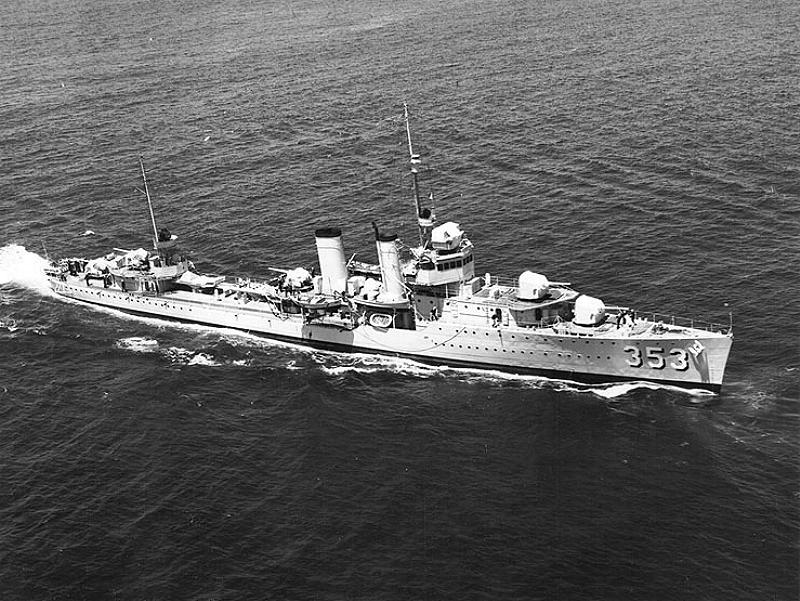
Name: Dale (DD-353)
Namesake: Richard Dale
Builder: Brooklyn Navy Yard
Laid down: 10 February 1934
Launched: 23 January 1935
Commissioned: 17 June 1935
Decommissioned: 16 October 1945
Struck: 1 November 1945
Fate: 20 December 1946, Sold
Displacement: 1,500 tons
Length: 341 ft 3 in (104.01 m)
Beam: 34 ft 3 in (10.44 m)
Draught: 16 ft 4 in (4.98 m)
Speed: 36 knots (67 km/h)
Complement: 160 officers and enlisted
Dale received 14 battle stars for World War II service. She was named for Richard Dale.
Dale launched 23 January 1935 by Brooklyn Navy Yard; sponsored by Mrs. E. C. Dale; and commissioned
17 June 1935, Commander W. A. Corn in command. Dale was decommissioned 16 October 1945 and sold
20 December 1946.
with ships of Destroyer Division TWO at Berth X-14, Pearl Harbor, T.H. The order of ships in the nest from
starboard to port was as follows: USS Aylwin, Farragut, Dale, Monaghan. The ship's head was 030. Boiler
number three was in use for auxiliary purposes. The Officer-of-the-deck, Ensign F.M. RADEL, U.S.N., acting
Commanding Officer, saw the first plane attack the U.S.S. Utah from Westward. General Quarters was
immediately sounded and orders given to set material condition Afirm and to light off all boilers. At 0810 fire
was opened on Japanese planes using the after .50 caliber machine guns, followed shortly thereafter by the
after five inch A.A. guns. The presence of the ships on either side of the Dale prevented the use of all forward guns.
The forward 24" searchlight made it impossible to bring the director to bear in the direction of the level bombing
attacks on the battleships. The 5" guns operated in local control with very poor results, the shots bursting well
behind and short of the targets, a squadron of level bombers flying at about 10,000 feet above the battleships on
alternately northerly and southerly courses. 0815, an enemy dive bomber attacking the U.S.S. Raleigh from
westward came under severe machine gun fire from all the ships in the nest, nosed down and crashed into the harbor.
U.S.S. Monaghan that the Dale was ready to get underway. While backing clear a torpedo apparently aimed at the
USS Raleigh passed under the bow of the Dale and exploded on Ford Island. 0844, stopped while the U.S.S. Monaghan
dropped depth charges on Japanese submarine close aboard the starboard side of the U.S.S. Curtiss. Changed
speed to 25 knots and proceeded out of harbor ahead of U.S.S. Monaghan. Until the Dale neared the submarine
net she did not come under the direct fire of the planes. Apparently the Japanese wished to sink a ship in the entrance,
thereby blocking the harbor, as the Dale came under severe dive bombing and machine gun attacks near the entrance.
Machine gun fire from the ship served to keep the attackers from approaching too closely, although there were several
close misses, which caused no damage. The bombs buried themselves in the bottom of the channel before exploding.
At 0907, cleared the entrance buoys and by stopping the port engine and coming hard left rudder, caused a flight of three
Japanese dive bombers to overshoot their mark. As they went by the starboard side close to the water, machine gun fire
from the Dale struck the leading plane causing it to burst into flame and to crash into the water on the outer starboard side
of the restricted area. The remaining two planes made a very half-hearted attempt to attack again but were driven off by
machine gun fire. 0911, the Dale established offshore patrol in sector one. Due to repeated airplane attacks the ship was
forced to make frequent changes of course and to run at high speed, thereby rendering the sound gear inoperative. 0927,
changed speed to 12 knots, patrolling sector one. High speed wakes and depth charging from other destroyers in the vicinity
rendered the sound gear practically useless.
column. After investigating the falsely reported presence of the three enemy transports off BARBERS POINT, formed inner
anti-submarine screen on the U.S.S. Detroit, Phoenix, St. Louis, and Astoria. The Dale was assigned station nine. The Task
Force speed was 25 knots. At 1410, the L.P. pinion bearings on the reduction gear of the port engine failed. An attempt was
made to stay with the assigned task force as the maximum speed obtainable with one engine was 22 knots. The Dale fell
steadily behind. The starboard engine began heating excessively, forcing a further reduction of speed to 10 knots. Retired
to the southward at 1654. Stopped at 1930 and lay to until 0500 the following morning attempting repairs. Rendezvoused
with Task Force at dawn but as full repairs to the engine were impossible without the assistance of the tender, the Dale could
not maintain her assigned screening station. Under orders of Commander Destroyers, Battle Force, the Dale established
off shore patrol in sector one until the entrance of Task Group 8.4 on Monday, December 8, 1941.
off the entrance buoys was observed to the Commanding Officer. Two other planes, both dive bombers, were claimed by
members of the crew to have been shot down by the Dale.
campaign area of New Guinea on 10 March. Dale returned to Pearl Harbor on escort and training duty until 11 May when she
departed for Mare Island and an overhaul. On 5 June she sailed from San Francisco, with others, to back up the task forces
engaged in the Battle of Midway from 6 July to 17 August. She was assigned to convoy duty between Viti Levu, Fijis, and Efate
and Espiritu Santo, New Hebrides, in preparation for the assault on Guadalcanal. She covered the landings, escorted transports
loaded with reinforcements to the bitterly contested island from 18 August to 21 September, then sailed to Pearl Harbor for escort
and training duty until 10 November. She sailed to screen battleships Washington and South Dakota into Pearl Harbor, continuing
with South Dakota to San Francisco.
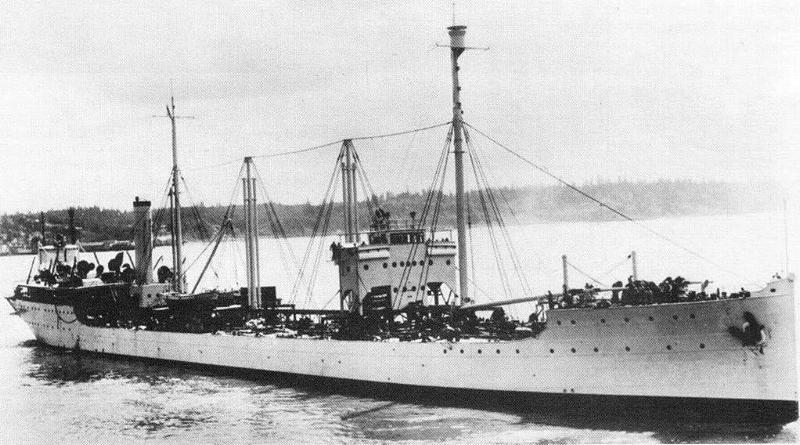

Launched: 11 July 1914
Commissioned: 5 June 1915 5 June 1934
Decommissioned: 18 December 1929
Struck: 19 May 1943
Honors and awards: World War I Victory Medal (with Transport clasp) -
American Defense Service Medal (with Fleet clasp)/American Campaign Medal
- Asiatic-Pacific Campaign Medal (1) - World War II Victory Medal
Fate: Sunk on 8 April 1943 by Japanese aircraft off Tulagi, Solomon Islands
Displacement: 5,723 tons light 14,800 tons full load
Length: 475 ft 7 in (144.96 m)
Beam: 56 ft 3 in (17.15 m)
Draft: 26 ft 8 in (8.13 m)
Speed: 14 knots
Complement: 317 officers and enlisted
Armament: 2 × 5 in (130 mm)/38 caliber guns 2 × twin 40-mm. guns 2 × twin 20-mm. guns
----------------------------------------------------------------------------------------
She was laid down 8 December 1913 by the Mare Island Navy Yard, Vallejo, California; launched 11 July 1914;
sponsored by Miss Dorothy Bennett; and commissioned 5 June 1915, Lt. Comdr. Richard Werner, USNRF, in command.
San Pedro 21 March 1942 with a convoy loaded with supplies for Hawaii. She continued convoy runs from California to Pearl
Harbor until 18 May when she arrived Tongatapu for fueling operations in the South Pacific. Throughout the summer she
cruised to New Caledonia, Espiritu Santo, and Efate, providing fuel for destroyers and transports en route to the Pacific
campaigns. The oiler departed Pago Pago 12 October and put into San Francisco 29 October for repairs and overhaul.
Kanawha resumed fueling operations upon her return to Pago Pago 13 February 1943. For the next two months she serviced
ships engaged in the struggle in the Solomon Islands.
in Tulagi harbor. At 1502, shortly after clearing the harbor, the slow and vulnerable oiler came under bomb attack. The first five
planes hit an oil tank under the bridge, causing fires to spread rapidly along the deck. Lt. Comdr. Bock ordered the ship
abandoned to minimize danger to his crew from burning oil on the surface. After rescue operations were underway, volunteers
returned on board and extinguished fires amidst exploding ammunition. The tug Rail towed Kanawha to the west side of
Tulagi where she was beached shortly before midnight. However, she slid off into deep water and sank before daybreak 8 April.
Nineteen of her crew were lost. Kanawha received one battle star for World War II service.
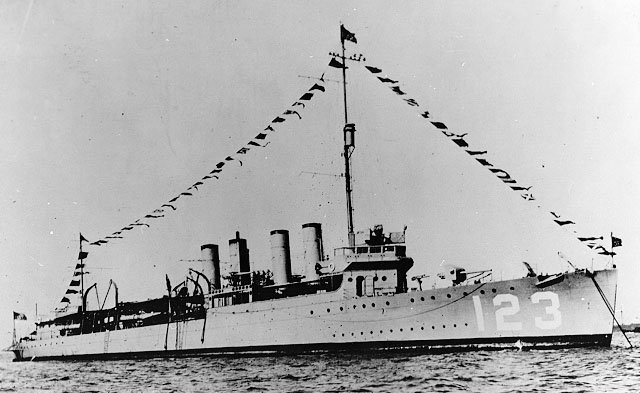
USS Gamble (DD 123) was named jointly in honor of two brothers, heroes of the War of 1812.
Lt. Peter Gamble, was born in Bordentown, N.J.; appointed midshipman 16 January 1809;
served on Macdonough's flagship Saratoga in the Battle of Lake Champlain, being killed in
action while in the act of sighting his gun 11 September 1814. Macdonough deplored his loss
and commended his gallantry in action. Lt. Col. John M. Gamble, USMC, was born in Brooklyn,
N.T., in 1791; appointed 2d Lt. 16 January 1809; and distinguished himself by coolness and
bravery in many enterprises, including critical encounters with hostile natives of the Marquesa
Islands during the absence of frigate Essex in 1813, and sailing a prize of Essex, with only a
four-man crew and without benefit of a chart in a remarkable 17-day voyage to the Hawaiian Islands.
He was breveted a Lt. Col. 3 March 1827 and died in New York 11 September 1836.
Built to Bath plans, built by Newport News, these Wickes versions were
slightly heavier but had a good cruising radius.
Displacement 1,213 Tons, Dimensions, 314' 5" (oa) x 31' 8" x 9' 10" (Max)
Armament 4 x 4"/50, 2 x 3"/23AA, 12 x 21" tt.
.
Machinery, 24,900 SHP; Direct Drive Turbines with Geared Cruising Turbines, 2 screws
Speed, 35 Knots, Crew 101.
Laid down by Newport News Shipbuilding on November 12 1917.
Launched May 11 1918 and commissioned November 29 1918.
Decommissioned at San Diego June 17 1922 and was berthed there until
recommissioning on May 24 1930.
Reclassified Light Minelayer DM-15 June 13 1930.
Fate Gamble was irreparably damaged by Japanese aircraft off Iwo Jima
February 17 1945 and scuttled off Guam July 16 1945.
5 of her crew were lost and remain on duty.
routine was broken by the first of the Japanese carrier-based planes which pounded American ships
in the harbor. Gamble's gunners joined the fire of other warships and saw one enemy plane fall into the
water on her port beam. After the attack she took antisubmarine patrol station in the screen of Enterprise,
and later guarded the approaches to Pearl Harbor. In mid-February 1942, she headed south in the escort
for a convoy to Pago Pago, Samoa, then joined Ramsey in laying a protective mine field off Tutuila . At the
end of March the two minelayers shifted to the Fiji Islands, to lay a minefield in Nadi waters 7–14 April.
Returning to Pearl Harbor for heavier armament, Gamble helped safeguard convoys to Midway during the
time of that crucial and historic battle, then headed south with Breese and Tracy to lay a defensive mine
field off the entrance to Second Channel, Espiritu Santo, New Hebrides Islands.
the old four-piper still carried antisubmarine gear. On the morning of 29 August, when her lookouts spotted a large
enemy submarine, she immediately went into action. After several depth charge attacks, Gamble ran through large
oil slicks, found deck planking, and observed a large air bubble break the surface. Later her victim was identified as
I-123, whose dying radio had signaled "under heavy enemy attack." That afternoon she proceeded at full speed to
Nura Island where she rescued four stranded aviators from Saratoga. Continuing to aid in the struggle for Guadalcanal,
she transported 158 Marines to the island 31 August, patrolled off Lunga Roads, then on 5 September assisted in freeing
William Ward Burrows and escorted her to Espiritu Santo, New Hebrides Islands. Her patrol, escort, and transport duty
continued as the drive for Guadalcanal pressed on to victory.
broke at times to disclose each to the other in perfect formation. Making 15 kn (28 km/h), each ship dropped a mine every
12 seconds, planting over 250 mines in 17 minutes across Blackett Strait, the western entrance to Kula Gulf and directly in
the favorite route of the worrisome "Tokyo Express." The ships then sped north to join the protective screen of Rear Admiral
Walden L. Ainsworth's cruiser-destroyer force before refueling at Tulagi. On the night of 7/8 May, four Japanese destroyers
entered the mined waters. One, Kuroshio, went down, two others, Oyashio and Kagero, were badly damaged and sent out
calls for help that brought Michishio to the scene. Aircraft, alerted by a coastwatcher, intercepted the rescue operation, sinking
the two destroyers and sending Michishio limping back to port, badly damaged.
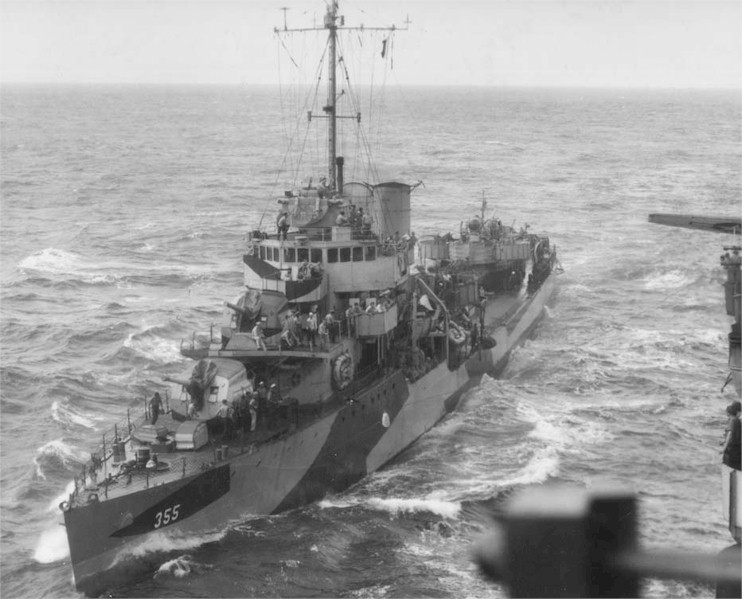
to be named for Lieutenant John Cushing Aylwin (1778–1812). Aylwin was laid down on
23 September 1933 by the Philadelphia Navy Yard, launched on 10 July 1934, sponsored by
Miss Elizabeth M. Farley, the 11-year-old daughter of Postmaster General James Farley, and commissioned
on 1 March 1935, with Commander Clarence Gulbranson in command.
Displacement: 1,375 tons
Length: 341 ft 3 in (104.01 m)
Beam: 34 ft 3 in (10.44 m)
Draft: 16 ft 4 in (4.98 m)
Speed: 37 kts (69 km/h)
Range:
6500 nmi at 12 knots
(12,000 km at 22 km/h)
Complement: 251 officers and enlisted
Armament:
As Built:
5 × 5"(127mm)/38cal DP (5x1),
8 × 21 inch (533 mm) T Tubes (2x4),
4 × .50cal (12.7mm) MG AA (4x1)
c1943:
1 × Mk 33 Gun Fire Control System
4 × 5" (127mm)/38cal DP (4x1),
8 × 21" (533 mm) T Tubes (2x4),
5 × Oerlikon 20 mm AA (5x1),
2 × Mk 51 Gun Directors
4 × Bofors 40 mm AA (2x2),
2 × Depth Charge stern racks
boiler was in operation to provide enough power for auxiliary services on board. Approximately half of
her men were enjoying leave and liberty that weekend. At 07:55 that Sunday morning, shortly before morning
colors, the sound of airplane engines surprised Aylwin's men and countless other sailors. At that time,
Japanese planes torpedoed the target ship Utah moored to a quay off Ford Island.
her main steam line within 15 minutes. At 08:29, Commander, Destroyers Battle Force directed his ships to get underway.
At about 08:50, a Japanese plane dropped a bomb that exploded some 75 yards off Aylwin's starboard bow. Eight
minutes later, Aylwin, leaving her stern wire and anchor chain behind, headed for the channel and the open sea.
B. Caplan, had served at sea for only some eight months—proceeded out of Pearl Harbor, stripping ship for war and
simultaneously maintaining a "continuous fire." Her machine gunners claimed to have downed at least three aircraft; but,
in the light of the tremendous volume of antiaircraft fire from all ships, her "kills" cannot be proven conclusively.
Lt. Comdr. Robert H. Rodgers, and other officers, in a motor launch about 1,000 yards off the entrance buoys.
Nevertheless, in view of ComDesRon 1's instructions, Aylwin could not slow down, but instead headed out to
sea for patrol duty, leaving most of her officers orphans on board the old flushdecker Chew. A little less than a
half hour later, Aylwin investigated a reported submarine sighting, but found nothing. During the patrol, the
destroyer vibrated abnormally because of a screw damaged soon after she got underway when a bomb
explosion near her starboard quarter threw her stern into a buoy.
up Rodgers and the division commander, Comdr. R. S. Riggs, on the way into the channel. The next day, Aylwin
got underway and conducted antisubmarine patrols in sector 2, off the entrance to Pearl Harbor. She made a
sound contact on 10 December. After going to general quarters, she dropped a five-charge pattern, but with no
confirmed damage. Entering Pearl Harbor again on the 11th, Aylwin underwent repairs to her damaged propeller.
On 12 December, after the smoke over Oahu had cleared, Comdr. Rodgers heaped praise on his abbreviated
crew for their actions in the first flush of war: "The conduct of the personnel was magnificent.... Every man more
than did his job and was eager to fight." Of Ensign Caplan, Rodgers wrote, "The conduct (of this man) ... in superbly
taking command for 36 hours during war operations of the severest type is a most amazing and outstanding achievement."
heavy cruisers Chicago and Portland and the destroyer Phelps, she took station ahead of Lexington. The next day,
destroyers Dewey and Worden, the cruiser Indianapolis, and the oiler Neosho joined the force.Two Japanese
carriers had joined the forces attacking Wake. This move prompted cancellation of the relief attempt. Wake fell on
23 December. After investigating several suspected submarine contacts en route, Aylwin covered the arrival of TF 11
at Pearl Harbor three days after Christmas. On the last day of 1941, Aylwin sortied from Pearl Harbor in the screen
of a convoy taking evacuees from the Hawaiian Islands to the west coast where she served five days into 1942.
.jpg)
CLASS - CALDWELL As Built.
Displacement 1,125 Tons, Dimensions, 315' 6" (oa) x 31' 3" x 11' 6" (Max)
Armament 4 x 4"/50, 2 x 1pdr AA, 12 x 21" tt..
Machinery, 18,500 SHP; Geared Turbines, 2 screws
Speed, 30 Knots, Crew 100.
Operational and Building Data
Laid down by Bath Iron Works, Bath Me. on August 22 1916.
Launched August 23 1917 and commissioned October 15 1917.
Manley decommissioned at Philadelphia June 14 1922 and berthed
with the reserve fleet until recommissioned May 1 1930.
Converted to high speed transport in 1938.
Reclassified APD-1 August 2 1940.
Reclassified to DD-74 June 25 1945.
Decommissioned at Philadelphia November 19 1945.
Stricken December 5 1945.
Fate Sold November 26 1946 Northern Metals, Philadelphia and broken up for scrap.
She was the second Navy ship named for Captain John Manley (c.1733–1793). Manley was laid down
on 22 August 1916 by the Bath Iron Works, Bath, Maine; launched on 23 August 1917; sponsored by
Miss Dorothy S. Sewall; and commissioned on 15 October 1917, Commander Robert L. Berry in command.
She was re-designated DD-74 on 17 July 1920.
SS Ulysses, and landed them at Charleston, South Carolina the following day. On 13 July 1942 Manley
transited the Panama Canal for duty with the Pacific Fleet. Touching the Society and Fiji Islands, she reached
Espiritu Santo, New Hebrides on 14 August, and loaded special cargo for Guadalcanal, invaded only one week earlier.
their cargo for wounded marines, they returned to Espiritu Santo on the 19th. Manley was ordered to take torpedoed
(DD-387) in tow for Tulagi harbor before nightfall. Since a Japanese surface force was approaching, it was necessary
to scuttle the destroyer. Manley took 99 survivors on board. Only two hours of fuel remained when the ship made it back
to Espiritu Santo on the 26th.
jungle green and covered her with camouflage nets. Thus arrayed, the high-speed transport made another trip to Guadalcana
l on 3 September 1942. After (APD-4) and (APD-3) were sunk at night of 5 September, she rescued five survivors the next morning.
The leathernecks were put ashore at 05:00, and were reinforced by paramarines from Manley at 11:30. During the operation
she bombarded Tasimboko village. The raid was a great success, and played an important role in final victory. Stores,
ammunition, and equipment were destroyed and many 75 mm guns were pulled off into deep water by Higgins boats.
Larger guns were dynamited, and their ammunition sunk. Reembarkation was completed by 18:30, and Manley returned to
Lunga Point to put the raiders ashore.
expected momentarily. With 200 marines, including wounded and dead, on board, she hoisted all boats and headed out
Lengo Channel with (DD-90) at 21:10. Manley had fuel for only one day's operations and so returned to Tulagi the next day.
Taking on enough fuel to reach Espiritu Santo, she was routed onward for voyage repairs at Nouméa, New Caledonia.
Guadalcanal. Task Force 65 (TF 65) put the marines ashore on 4 November 1942, and troops from Manley and
McKeanreinforced them on the 8th.
SS Pomona to Espiritu Santo. Here she embarked another company of raiders and sailed for Lunga Point, Guadalcanal
where the raiders debarked. The PT boats and torpedoes were then delivered to Tulagi, Solomon Islands. In the following
months, the high-speed transport was constantly engaged in the risky business of running supplies into Guadalcanal and
escorting other ships through the dangerous Solomons.
Manley set sail for Hawaii. From Pearl Harbor, the veteran four-piper escorted a convoy south to Funafuti to resume her
former duties in the Solomon Islands.
the invasion of the Marshall Islands. She sortied on 22 January 1944 with TF 52. On the 30th she and (DD-239) were detached
to make a dawn strike on Carter and Cecil Islands of Kwajalein Atoll. All boats and troops were launched shortly before sunrise
on 31 January 1944, and by 09:00 reported that they had killed 13 of the enemy on the island at a cost of one American killed
and one wounded.
dawn on 5 February, and Manley was designated fire support ship. The area was well-covered, and the operation went off on schedule.
troops for future landings.
arrived off Saipan on the night of 14 June and landed their marines on established beaches south of Garapan on 16 June.
Thereafter, except for a trip to Eniwetok for supplies and night harassing fire on Tinian Town and airports on the nights of 9, 12,
and 18 July Manley operated in the transport screen until 22 July. She returned to Eniwetok on the 22nd and, after a trip to Kwajalein,
sailed to Pearl Harbor, arriving on 9 August, she began preparations for the next operation.
proposed invasion of Yap. She left Pearl Harbor on the 15th and proceeded via Eniwetok to Manus, Admiralty Islands. There
word arrived that the operation against Yap had been canceled and that the forces assembled would strike Leyte in the Philippine.
Manley was then assigned to the bombardment and fire support group which arrived in Leyte Gulf early on 18 October.
up casualties from (DD-563), and transferred them to (BB-38). After marking a navigational buoy during the early morning hours
of the 20th, she headed toward Hollandia with TransDiv 28, on the evening of 21 October.
the 27th. After an escort trip to New Guinea, Manley returned to Seeadler Harbor. In mid-December, she shifted to Noemfoor Island
for tactical exercises and training for the liberation of Luzon.
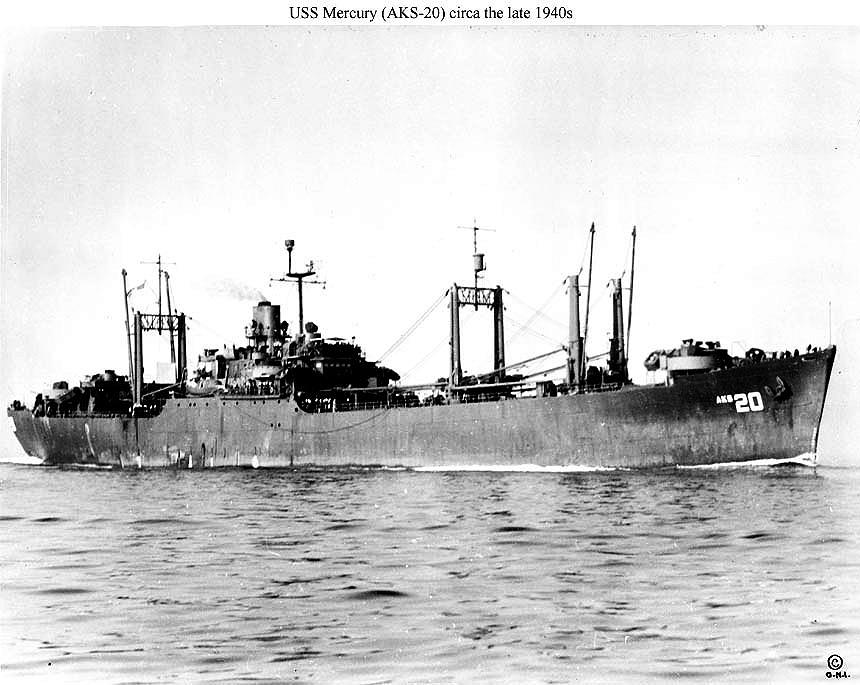

Laid down: date unknown
Launched: 15 July 1939
Acquired: 20 June 1941
Commissioned: 1 July 1942
Decommissioned: 28 May 1959
Struck: 1 August 1959
Fate: scrapped in 1975
Beam: 63 ft (19 m)
Draft: 25 ft 9 in (7.85 m) (max)
Propulsion: diesel engines, single shaft, 6,000shp
Speed: 15.5 kts.
Complement: 265
Armament: one 5 in (130 mm) dual purpose gun mount;
four single 3 in (76 mm) dual purpose guns;
eight single 20 mm AA gun mounts
She was responsible for delivering necessary goods and equipment to ships and stations in the war zone.
Federal Shipbuilding & Dry Dock Go., Kearny, New Jersey, 15 July 1939; sponsored by Mrs. Royal S. Copeland;
purchased on the ways by Moore McCormack Lines and placed in operation by them as SS Mormactern
30 October 1940; acquired by the Navy 20 June 1941; converted, and commissioned as Mercury
1 July 1942, Lt. Comdr. G. W. Graber, Merchant Navy (United Kingdom), in command.
runs from the west coast to the South Pacific and ending with underway replenishments for the fast carrier forces.
The converted merchantman completed her maiden wartime voyage at San Francisco, California, 27 September
1942 having carried a mixed cargo, which included drummed petroleum products, landing mats, dynamite,
engineering equipment, and food, to Noumea and Guadalcanal. Over the next 15 months she continued to
carry essential materiel to the South Pacific, supporting Allied forces as they pushed through the
Solomons and the Gilberts.
.jpg)
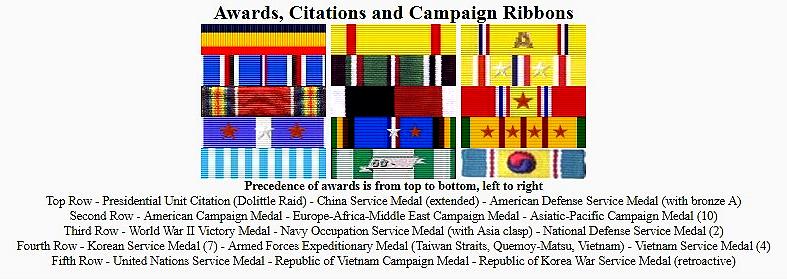
to be named for the Cimarron River in the Southwestern United States. She was launched 7 January 1939 by
Sun Shipbuilding and Drydock Company, Chester, Pennsylvania; sponsored by Mrs. William D. Leahy; and
commissioned 20 March 1939 with Lieutenant Commander William W. Behrens, Sr. in command.
coast ports and Pearl Harbor, making 13 such voyages until she sailed for the east coast on 19 August 1940.
After repairs and alterations, she began oil runs on the east coast, principally between Baton Rouge and Norfolk,
until August 1941, when she took part in amphibious operations. From 5–16 September she put to sea with a transport
convoy bound for Iceland, and voyaged north again from 12 October to 5 November to refuel ships at Placentia Bay.
On 15 November 1941, she joined a convoy at Trinidad bound for Singapore with reinforcements, but was detached
from the convoy on 9 December at Cape Town, South Africa. Returning to Trinidad on 31 December, she operated
from Brazilian ports to Iceland until 4 March 1942, when she cleared Norfolk for San Francisco.
returned to Pearl Harbor 16 October. She sailed once again 14 November to fuel in support of the Gilbert Islands
campaign, returning 1 December, and sailed to San Pedro, California to reload 12 December to 4 January 1944.
Clearing Pearl Harbor 13 January 1944, she supported the Marshall Islands operation and the February attacks
on
Truk from Majuro until 6 June; the Marianas operation from Eniwetok until 26 August;
and the Palau Islands operation from Ulithi
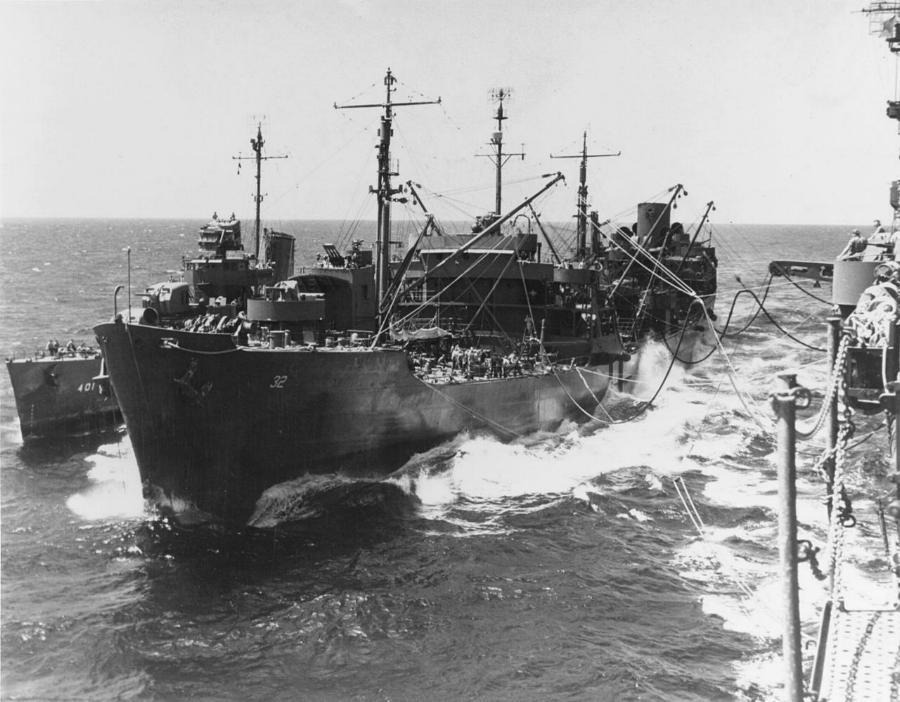
The U.S. Navy fleet oiler USS Guadalupe (AO-32) refuels the destroyer USS Maury (DD-401) and the aircraft carrier
USS Lexington (CV-16) at sea in the Gilbert Islands area, 25 November 1943.
Note the 1.1"/75 caliber anti-aircraft gun (28 mm) aboard Guadalupe.
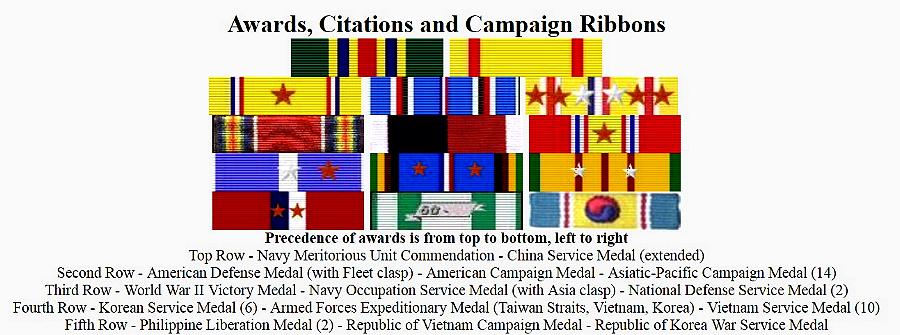
it was named for the Guadalupe River in Texas.
Dry Dock Company at Newport News, Virginia; sponsored by Mrs. W. L. Inslee, wife of the late manager of the
Traffic Division, Marine Department, Standard Oil of New Jersey; taken over by the Maritime Commission as
MC Hull #12; acquired by the Navy 1 June 1941; and commissioned 19 June 1941,
Commander Harry R. Thurber in command.
docked at the Brooklyn Navy Yard. Receiving as deck cargo six PT boats later to form the famous squadron
commanded by Lieutenant Commander John D. Bulkeley, Guadalupe sailed for the Western Pacific
on 19 August. After discharging cargo and oil at Pearl Harbor, Manila, and Cavite, the tanker returned to Norfolk,
Virginia 13 November via San Diego. After America's sudden plunge into war, she put into Baltimore to be fitted with guns.
of the long and bloody war. After months of developing and refining techniques for refueling at sea, a science then in
its infancy, Guadalupe sailed from Pearl Harbor 2 June 1942 to refuel American ships participating in the momentous
Battle of Midway,5 June 1942: 550 miles E of Midway. About 0400 (I), I-156 sights fleet oiler USS GUADALUPE (AO-32)
escorted by two destroyers but fails to reach a favorable firing position. Except for I-168, I-156 is the only submarine that makes
a contact with the Americans during the battle. the first naval defeat inflicted on the Japanese in 350 years. From Midway Atoll
Guadalupe sailed north to spend the rest of the summer supporting American forces in the Attu campaign.
months of 1942 fueling warships operating in and around Guadalcanal. The first half of 1943 saw her in overhaul in the
United States and operating in the Aleutians, with two shuttle trips to Pearl Harbor with fuel and planes. Departing Pearl
22 August Guadalupe sailed to the central Pacific to support the Gilbert Islands campaign, working with such famous
fighting ships as Essex, Independence, Washington, Enterprise, Lexington, and Yorktown.